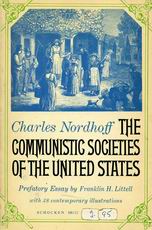

|
|

The Communistic Societies of the United States
Nordhoff, Charles
Publisher: Schocken Books, USAYear First Published: {12083 The Communistic Societies of the United States COMMUNISTIC SOCIETIES OF THE UNITED STATES Nordhoff, Charles Schocken Books USA Describes a dozen Utopian societies. 1875 1965 439pp BC12083s-CommunisticSocieties.jpg B Book Charles Nordhoff describes a dozen Utopian societies of the past and present. He gives detailed accounts of various communities and their ideologies. Groups living collectively did so for varying reasons and to varying results. Nordhoff analyzes these results to come up with his own theory of collective living. The failures of groups in the past can be inspected and avoided by the groups of the future. <br> <br>In this commentary on communistic societies, Nordhoff presents a number of models for the "good life". These models are anti-capitalist in nature and aim to provide a more human and social way of living and working together. <br> <br>With a new introductory essay by Franklin H. Littel, the book is made up of 14 parts. Most of these are focused on a single collective. A history, description of customs, explanation of ideas and revelation of the degree of success of each community is provided. Some communities have published literature that is referenced by Nordhoff. If the community failed in the end, Nordhoff provides reasons and methods for such conflicts to be avoided. Later sections look at non-communist colonies and statistical comparisons of the different ideologies. Maps, illustrations and charts are embedded throughout the work. <br> <br>By looking at many communistic societies together, Nordhoff can provide advice and analysis to future collectives. His own theories are based off the research and information included in this book. <br> <br>[Abstract by Mia Manns] <br> <br> <br> <br>Table of Contents <br> <br>1. Introduction <br>2. The Amana Society <br>3. The Harmonists at Economy <br>4. The Separatists of Zoar <br>5. The Shakers <br>6. The Oneida and Wallingford Perfectionists <br>7. The Aurora and Bethel Communes <br>8. The Icarians <br>9. The Bishop Hill Colony <br>10. The Cedar Vale Commune <br>11. The Social Freedom Community <br>12. Three Colonies - Not Communistic <br>13. Comparative View and Review <br> <br>Bibliography <br>Index CX6223 1 true true false CX6223.htm [0xc0009f0ba0 0xc000e9cbd0 0xc000f01740 0xc00017b800 0xc00032d740 0xc002094c30 0xc0000e1710 0xc0001709c0 0xc000171ce0 0xc0001cd650 0xc000002390 0xc0002b3320 0xc000c3ec90 0xc0019a7da0 0xc0019cef60 0xc00007b5c0 0xc0002185a0 0xc000299ce0 0xc000337d10 0xc001c9a6f0 0xc0021701b0 0xc002784c90 0xc0027c1d40 0xc0027eeff0] Cx} Year Published: 1965 Pages: 439pp Resource Type: Book Cx Number: CX6223 Describes a dozen Utopian societies. Abstract: Charles Nordhoff describes a dozen Utopian societies of the past and present. He gives detailed accounts of various communities and their ideologies. Groups living collectively did so for varying reasons and to varying results. Nordhoff analyzes these results to come up with his own theory of collective living. The failures of groups in the past can be inspected and avoided by the groups of the future. In this commentary on communistic societies, Nordhoff presents a number of models for the "good life". These models are anti-capitalist in nature and aim to provide a more human and social way of living and working together. With a new introductory essay by Franklin H. Littel, the book is made up of 14 parts. Most of these are focused on a single collective. A history, description of customs, explanation of ideas and revelation of the degree of success of each community is provided. Some communities have published literature that is referenced by Nordhoff. If the community failed in the end, Nordhoff provides reasons and methods for such conflicts to be avoided. Later sections look at non-communist colonies and statistical comparisons of the different ideologies. Maps, illustrations and charts are embedded throughout the work. By looking at many communistic societies together, Nordhoff can provide advice and analysis to future collectives. His own theories are based off the research and information included in this book. [Abstract by Mia Manns] Table of Contents 1. Introduction 2. The Amana Society 3. The Harmonists at Economy 4. The Separatists of Zoar 5. The Shakers 6. The Oneida and Wallingford Perfectionists 7. The Aurora and Bethel Communes 8. The Icarians 9. The Bishop Hill Colony 10. The Cedar Vale Commune 11. The Social Freedom Community 12. Three Colonies - Not Communistic 13. Comparative View and Review Bibliography Index Subject Headings
|